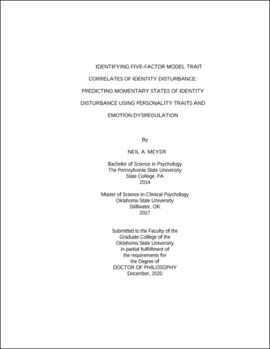| dc.contributor.advisor | Mullins-Sweatt, Stephanie N. | |
| dc.contributor.author | Meyer, Neil A. | |
| dc.date.accessioned | 2021-05-25T20:32:09Z | |
| dc.date.available | 2021-05-25T20:32:09Z | |
| dc.date.issued | 2020-12 | |
| dc.identifier.uri | https://hdl.handle.net/11244/329923 | |
| dc.description.abstract | Borderline personality disorder (BPD) is a highly debilitating disorder with symptoms spanning emotion dysregulation and identity disturbance. Competing theories purport that the impairment associated with BPD is due to identity disturbance (Kernberg, 1992), while others suggest it is due to emotion dysregulation (Linehan, 1992). Both identity disturbance and emotion dysregulation are transdiagnostically linked (Neacsiu et al., 2014) and are associated with numerous public health concerns, including suicide ideation (Ren et al., 2018). Additionally, while clarity has increased regarding the definition and measurement of emotion dysregulation (Gratz & Roemer, 2004), identity and identity disturbance have been difficult to define and measure (Westen & Heim, 2003). This is especially problematic in BPD, as its presence or absence may affect diagnostic reliability, case conceptualization, and potential treatment. The current study first sought to relate facets of the FFM to identity disturbance to develop an FFM trait profile. The second aim of this study was to disentangle actual experiences of identity disturbance reported via ecological momentary assessment. This aim was tested by using the developed FFM trait profile alongside a measure of emotion dysregulation to predict momentary states of identity disturbance. Results from Study 1 provided support for a 5-facet profile and a 10-facet trait profile. Results from Study 2 demonstrated evidence of good fit indices for the 5-facet profile using Structural Equation Modeling, though mediation was not supported. Evidence of direct effects of FFM facets on emotion dysregulation and identity disturbance events was found using path analysis via multiple regression. Support for the 10-facet profile did not demonstrate adequate evidence of good fit, though results of path analyses were consistent with the 5-facet profile. Overall, results of this study suggest that facets of the FFM significantly relate to identity disturbance, though emotion dysregulation did not significantly mediate this relationship. Preliminary evidence does support the notion that some personality traits may predict experiences of identity disturbance. Implications and limitations of this research are discussed. | |
| dc.format | application/pdf | |
| dc.language | en_US | |
| dc.rights | Copyright is held by the author who has granted the Oklahoma State University Library the non-exclusive right to share this material in its institutional repository. Contact Digital Library Services at lib-dls@okstate.edu or 405-744-9161 for the permission policy on the use, reproduction or distribution of this material. | |
| dc.title | Identifying five-factor model trait correlates of identity disturbance: Predicting momentary states of identity disturbance using personality traits and emotion dysregulation | |
| dc.contributor.committeeMember | Wells, Tony T. | |
| dc.contributor.committeeMember | Wingate, LaRicka R. | |
| dc.contributor.committeeMember | Koch, Julie M. | |
| osu.filename | Meyer_okstate_0664D_16914.pdf | |
| osu.accesstype | Open Access | |
| dc.type.genre | Dissertation | |
| dc.type.material | Text | |
| dc.subject.keywords | borderline personality disorder | |
| dc.subject.keywords | ecological momentary assessment | |
| dc.subject.keywords | emotion dysregulation | |
| dc.subject.keywords | five-factor model | |
| dc.subject.keywords | identity disturbance | |
| dc.subject.keywords | personality traits | |
| thesis.degree.discipline | Psychology | |
| thesis.degree.grantor | Oklahoma State University | |
